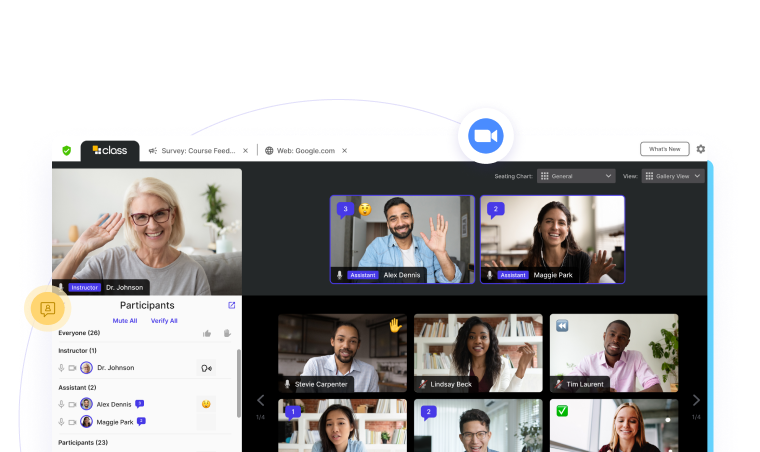
Gerald Glynn is a seasoned enterprise sales professional with 20+ years in software, including Adobe Connect, Zoom, and now Class. Known for his consultative approach, he helps organizations adopt web conferencing, webinars, virtual classroom, and collaboration tools that drive engaging and impactful virtual experiences.

Gerald Glynn is a seasoned enterprise sales professional with 20+ years in software, including Adobe Connect, Zoom, and now Class. Known for his consultative approach, he helps organizations adopt web conferencing, webinars, virtual classroom, and collaboration tools that drive engaging and impactful virtual experiences.

Training programs are designed to spark growth and help employees build the skills they need to succeed. But what happens once the session wraps up and everyone heads back to their day-to-day work? Post-training engagement remains a persistent challenge for many organizations, even after all the planning and effort that goes into a successful training program.
We know that people forget much of what they learn if it isn’t put into practice. Within a week of training, most learners will remember less than 20% of what was covered if they haven’t had a chance to apply it. This is called the “forgetting curve,” and it quietly undermines even the most well-designed programs.
It’s not for lack of effort. Companies invest in quality content and great instructors. Still, if the learning stops the minute training ends, most of that investment won’t make a difference where it counts: on the job.
Let’s look at how organizations can keep learners connected to new skills, extend the value of training, and build a culture where learning never really stops.
Most virtual training programs focus on the event itself. Learners log in, complete their coursework, and then move on. There’s rarely a clear plan for what comes next.
Without ongoing reinforcement, new information fades fast. Learners may want to apply new skills, but when support is missing or priorities shift, the pressure to return to old habits is strong. Managers and supervisors often aren’t looped in or equipped to coach employees on what they’ve just learned, leaving learners on their own to bridge the gap between training and practice.
Organizations that close this gap see stronger results. They treat the end of training as the start of a new phase that is focused on support, follow-up, and applied learning.
Extending learning beyond the training session creates benefits that ripple outward, from stronger employee performance to measurable business impact. Research consistently shows that companies with strong learning cultures outperform their peers in productivity, innovation, and retention. On the flip side, disengagement after training leads to wasted investments: training budgets that don’t translate to real behavior change, lost momentum on strategic initiatives, and employees who revert to old habits.
When employees stay engaged after a session, they are more likely to apply new skills directly on the job, which drives measurable improvements in performance.
The “forgetting curve” is only part of the story. Cognitive science tells us that memory and learning are strengthened through techniques like spacing, retrieval practice, and reinforcement in context. When employees are prompted to recall and apply what they’ve learned at intervals over time, they are far more likely to retain and use those skills.
Behavioral science adds another layer: people are more likely to adopt new habits when they are supported by cues, reinforcement, and accountability. Post-training engagement strategies—such as microlearning, manager check-ins, and recognition—align directly with these principles. These strategies give employees the chance to turn new knowledge into real habits.
Short, targeted reminders can make a significant difference. Scheduled follow-up emails or in-app notifications help learners revisit essential ideas. Microlearning modules, like quick quizzes, short videos, or recap slides, fit easily into the workday and make it easier to remember and apply new knowledge.
Learning sticks best when people talk about it and try it out with others. Encourage supervisors to check in regularly with employees about how they’re applying new skills. Provide managers with simple guides or prompts to start these conversations. Setting up peer discussion groups or informal check-ins can also help learners swap ideas and solve challenges together.
This is especially important at a time when manager involvement in employee growth is declining. According to the 2025 LinkedIn Workplace Learning Report, only 15% of employees said their manager helped them build a career plan in the past six months, a five-point drop from 2024. Managers are under increasing time pressure, but they remain critical to employee development. Equipping them with their own dedicated training, easy-to-use resources, and recognition for supporting career growth can help reverse this trend and ensure they’re actively reinforcing skills after training.
A sense of community encourages ongoing engagement. Discussion forums, group chats, and collaborative projects give learners a place to share wins, ask questions, and get advice. Group challenges or friendly competitions can keep the experience fresh and encourage everyone to stay involved.
Too often, traditional recordings end up as passive, uninspiring files that learners fast-forward through or skip altogether. They’re hard to navigate, don’t encourage participation, and rarely reinforce skills in a meaningful way.
Class’s Interactive Recordings transform replays into active learning experiences, letting employees revisit sessions as if they were happening live. Learners can pause, engage with polls, complete built-in quizzes, and explore shared resources at their own pace. When a concept doesn’t click the first time, or when they need a quick refresher, employees can go back to the exact moment they need and actively work through the material again.
Interactive Recordings also ensure that absent learners aren’t left out. Employees who miss a live session can engage with the recording as if they were there in real time, answering the same questions, interacting with the same content, and benefiting from the same instruction as their peers.
Recognition builds momentum. Use available data and analytics to monitor participation and skill growth. Celebrate milestones, like completion of a follow-up activity, contributions to a discussion, or improvements in job performance. Simple shoutouts in a team meeting or digital badges can boost morale and keep people invested.
Even the best strategies can fall flat without the right culture. Organizations that succeed in extending learning beyond the classroom have leaders who model continuous learning, managers who make space for practice, and teams that see learning as part of their everyday work.
This cultural foundation matters because it shifts learning from an isolated event to an integrated part of the employee experience. Instead of asking “Did the training session go well?” leaders begin asking “How are we reinforcing, applying, and building on what we learned?”
Building this kind of culture requires intentionality, from aligning incentives and recognition with learning behaviors to creating safe spaces where employees feel comfortable experimenting with new skills.
Building a culture where learning continues long after the session ends requires intention and the right support. What steps is your organization taking to keep the learning alive?
If you’re looking for new ways to keep your teams engaged after training, see how Class’s interactive recordings and collaboration tools can help. Reach out to start the conversation.

Gerald Glynn is a seasoned enterprise sales professional with 20+ years in software, including Adobe Connect, Zoom, and now Class. Known for his consultative approach, he helps organizations adopt web conferencing, webinars, virtual classroom, and collaboration tools that drive engaging and impactful virtual experiences.

Gerald Glynn is a seasoned enterprise sales professional with 20+ years in software, including Adobe Connect, Zoom, and now Class. Known for his consultative approach, he helps organizations adopt web conferencing, webinars, virtual classroom, and collaboration tools that drive engaging and impactful virtual experiences.
Get our insights, tips, and best practices delivered to your inbox

Sign up for a product demo today to learn how Class’s virtual classroom powers digital transformation at your organization.

Features
Products
Integrations